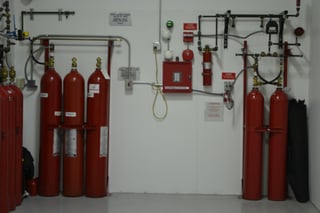
The Server Room: aka your business’ brain and the worst possible place for a fire to start. The equipment in the server room, though expensive, is replaceable.
The data it contains, on the other hand, is not.
Even brief exposure to smoke from a fire can lead to extensive damage to your server room’s equipment. The corrosive sulfur and chloride by-products from the smoke alone are enough to corrode metal materials over time, even after just a brief exposure. It can cause damages to disk read/write heads, tape transport mechanisms, and can ultimately result in a “head-crash,” which means loss of data and damage to the drive.
All this just from brief smoke exposure. There are of course further damages from exposure to sustained elevated temperatures and flames.
No business can afford such a catastrophe.
Fortunately, there are numerous things you can do to protect your server room and IT equipment from fire and fire-related damages.
To eliminate the risk of fire and minimize damage, it is important to understand what the most common causes of server room fires are, the best strategies to avoid server room fire hazards, and the type of fire suppression needed to protect data in the server room in case of a fire.
Common Causes of Server Room Fires
The NFPA reports a few top causes of server room fires, all of which are perfectly avoidable. Here are the three most common:
- Short circuiting and/or overloading of electrical components: when electrical equipment short circuits or becomes overloaded, it quickly becomes a serious fire hazard. This is in fact the number one reason for fires in server rooms.
- Subfloor wiring: another major cause of server room fires is malfunctioning or faulty wiring running through the subfloor. This is a harder issue to detect and is most certainly hazardous.
- Overheating: electronics run hot, and when they are not allowed proper room to ventilate and/or are not kept properly cool, they overheat, which is the third major cause of server room fires. A room full of overheating equipment is a fire waiting to happen.
7 Tips to Prevent Server Room Fires & Minimize Damage
The old adage: “a teaspoon of prevention is worth a pound of cure” certainly holds true here. Most server room fires are easily preventable, which is of course the most affordable option.
There are many ways you can significantly decrease the chance of a fire in your server room. Following are just a few of the best tips you can apply in your with relative ease:
- Use appropriate temperature and humidity levels: to help keep your equipment from overheating, keep the room temperature between 68-71°F. Additionally, maintaining 40-60% humidity level will decrease the risk of static electricity, which can be a fire hazard.
- Keep things tidy: make sure wires are plugged in and properly stored. Remove unused cables and wires. Remove unnecessary items that could act as fuel for a fire, such as paper and trash.
- Ensure proper ventilation: do not place servers and equipment too close together or set paper or objects on top of them. The equipment needs proper room to breathe and stay cool to avoid overheating.
- Keep the electronics clean: do not allow dust and other debris to settle on or in the equipment, as it could contribute to overheating and act as additional fuel for a fire.
- Perform regular cord and equipment checks: check cords and outlets regularly for frayed or damaged cords or outlet covers. Regularly check on your servers’ power supply with diagnostic software so that you can catch it before it fails or overheats.
- Have a fire risk assessment performed: whether you already have a server room or are in the process of planning one, bring in the professionals, like Koorsen Fire & Security, to ensure that it adheres to NFPA standards, which will significantly decrease your risk of fire.
- Schedule regular inspection and maintenance: your fire suppression systems and server room wiring and equipment should undergo regular inspection and maintenance to ensure all is working properly.
If The Worst Should Happen: Fire Suppression Systems for Server Rooms
Sometimes, despite our best steps and precautions, the worst can still happen. So what if a fire does start in your server room? Are you prepared with the proper fire suppression system?
Water sprinklers are great and should still be located in your server room, but for the obvious reason that water damage to electronics can be just as devastating as smoke and fire damage, they are not the ideal first measure.
Clean agent fire suppression is the way to go. Capable of suppressing and extinguishing fires with minimal damage to electrical equipment, this type of suppression relies on gases and chemicals to suppress the fire in its early, insipient stage.
This form of suppression can spread throughout the room and even into electronics (helpful should the fire be starting inside of one) without damaging it or the precious data it contains.
But, it is important to know/remember:
- Clean agent systems only suppress a fire as long as the agent is present.
If the room is not properly sealed and the agent can seep out, or if the power is not cut off, the electrical issue that started the fire will continue to be present and the fire could reignite.
- Clean agent suppression is intended to protect the contents of the server room. The goal of clean agent suppression is catching the fire early – quick detection, quick suppression that lasts until emergency personnel can arrive.
What this means, though, is that clean agent fire suppression is not adequate for extinguishing a strong fire nor is it intended to protect the entire building.
This is why keeping fire sprinklers in the room is a good idea so that they can act as a back-up should the clean agent be unable to keep the fire suppressed. Sprinklers are there to protect the building and extinguish a fire.
- For a clean agent suppressant to work effectively, the server room needs to be sealed and the HVAC system, ideally, have an automatic shut-down in the event of a suppression system discharge.
How’s Your Server Room Safety?
Not sure whether your current or future-planned server room has what it takes to prevent or resist a fire?
When you call Koorsen Fire & Security for your fire suppression system needs, they will ensure that a door fan test is performed and the proper clean agent suppression system is installed.
If they find an issue with the structure of the room that would make the system ineffective, they will let you know and help direct you toward contractors who can help resolve the structural issues so that the fire suppression system can work properly. They will also provide guidance if they see any potential hazards or anything not adhering to NFPA 75.
Give Koorsen a call today or contact us online to help protect your business’ most vital asset.


